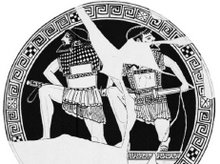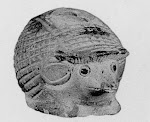It has long been a goal of mine to assist groups of reenactors in generating quantitative data on various aspects of hoplite combat. This would be hard data, numbers that we could crunch to provide a true comparison between individuals and between hoplite reenactment groups.
There are many elements of hoplite combat that need to be tested, but my main concern is the safety of reenactors, thus no othismos for the time being. I've attached an image that could serve as a first attempt at a standardized test for hoplite groups. This set-up is a basic stabbing test. The data will give us a rate of striking for a hoplite in formation. I think this rate can be fairly well correlated to the offensive potential of hoplites engaged in doratismos. By altering the size of the target and requiring more accuracy, we can simulate strikes that would "kill" or wound. Because we are simulating group combat, at least three men side by side are needed to create a hoplite bounded on both flanks by other men. For our purposes only the central hoplite can be have his strike number recorded, for only he in flanked by others.

Within this basic set-up, we can alter a variety of variables:
Duration of test period: stamina
Size of target (moving target): accuracy
Grip type: underhand or overhand
Number of ranks in the phalanx
Lateral inter-hoplite spacing
Fore-and-aft spacing
Number of ranks stabbing forward at targets (1, 2 or 3)
Striking while under physical pressure from rear ranks of various length files
Change focus to record the striking rate of the second or third man in the file
Here is a second simple test. This one is to quantify the loss of cohesion that we all know occurs as a phalanx advances rapidly in close order. You simply measure the distance between a point on any adjacent hoplites in rank or file- I suggest the left foot. Then you have the formation advance at whatever speed and in whatever formation you wish to test. The men are made to stop at some signal, a horn or simple shout is preferable to a demarkation so that it is harder to predict. Then you simply remeasure the distances between hoplites. The deviation between each pair from their original spacing is a measure of a loss of order. From there you can ask if they became tighter or looser. The test can be repeated varying the with different starting formations, individual advancing posture, distance, and speed of advance, etc.

I've got a few groups signed on for some testing and welcome any who seek to join. Whatever we are able to do I will run appropriate statistics on and we'll try to publish someplace so that we can all refer to it. Obviously a large number of individuals being tested is good to control for variation between hoplites, but I'd like to get multiple groups involved as well if possible. I welcome discussion on this experiment and hopefully we can plan other experiments as well.



